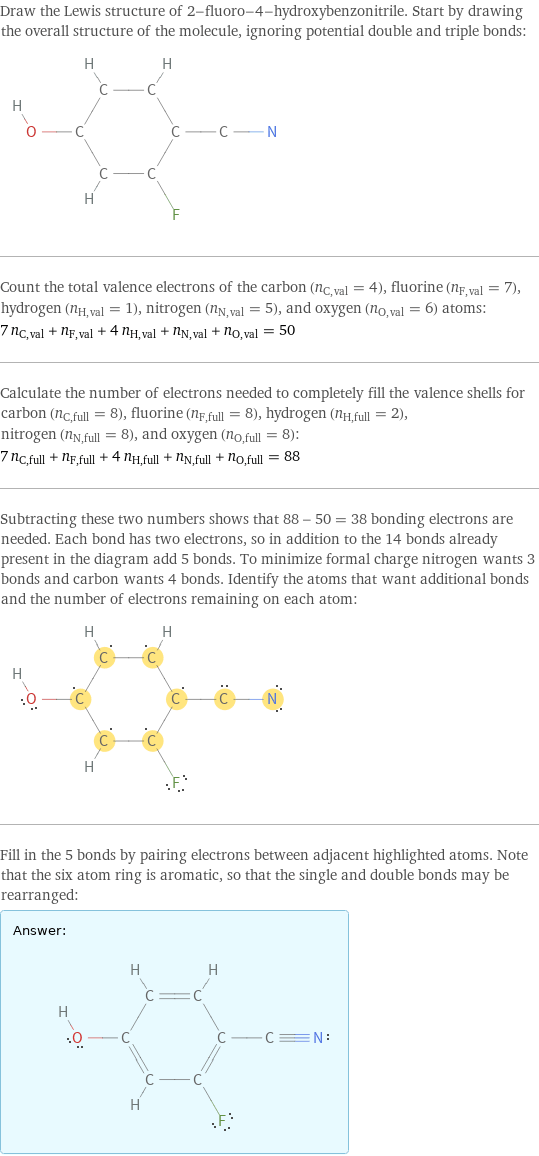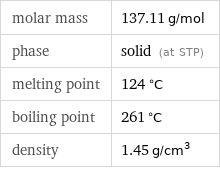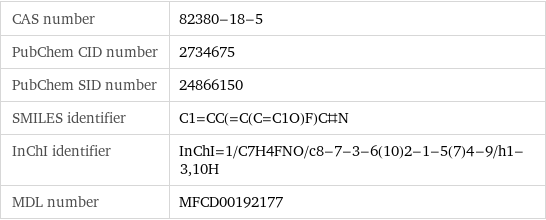Input interpretation

2-fluoro-4-hydroxybenzonitrile
Chemical names and formulas

formula | FC_6H_3(OH)CN Hill formula | C_7H_4FNO name | 2-fluoro-4-hydroxybenzonitrile alternate names | 2-fluoro-4-cyanophenol | 2-fluoro-4-hydroxy-benzonitrile mass fractions | C (carbon) 61.3% | F (fluorine) 13.9% | H (hydrogen) 2.94% | N (nitrogen) 10.2% | O (oxygen) 11.7%
Lewis structure

Draw the Lewis structure of 2-fluoro-4-hydroxybenzonitrile. Start by drawing the overall structure of the molecule, ignoring potential double and triple bonds: Count the total valence electrons of the carbon (n_C, val = 4), fluorine (n_F, val = 7), hydrogen (n_H, val = 1), nitrogen (n_N, val = 5), and oxygen (n_O, val = 6) atoms: 7 n_C, val + n_F, val + 4 n_H, val + n_N, val + n_O, val = 50 Calculate the number of electrons needed to completely fill the valence shells for carbon (n_C, full = 8), fluorine (n_F, full = 8), hydrogen (n_H, full = 2), nitrogen (n_N, full = 8), and oxygen (n_O, full = 8): 7 n_C, full + n_F, full + 4 n_H, full + n_N, full + n_O, full = 88 Subtracting these two numbers shows that 88 - 50 = 38 bonding electrons are needed. Each bond has two electrons, so in addition to the 14 bonds already present in the diagram add 5 bonds. To minimize formal charge nitrogen wants 3 bonds and carbon wants 4 bonds. Identify the atoms that want additional bonds and the number of electrons remaining on each atom: Fill in the 5 bonds by pairing electrons between adjacent highlighted atoms. Note that the six atom ring is aromatic, so that the single and double bonds may be rearranged: Answer: | |
3D structure

3D structure
Basic properties

molar mass | 137.11 g/mol phase | solid (at STP) melting point | 124 °C boiling point | 261 °C density | 1.45 g/cm^3
Units

Solid properties (at STP)

density | 1.45 g/cm^3
Units

Chemical identifiers

CAS number | 82380-18-5 PubChem CID number | 2734675 PubChem SID number | 24866150 SMILES identifier | C1=CC(=C(C=C1O)F)C#N InChI identifier | InChI=1/C7H4FNO/c8-7-3-6(10)2-1-5(7)4-9/h1-3, 10H MDL number | MFCD00192177